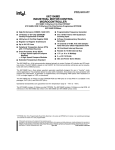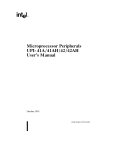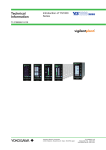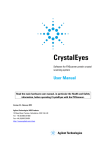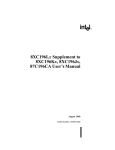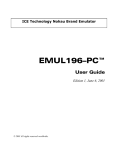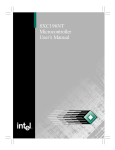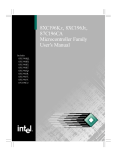Download 87C196JV 20 MHz ADVANCED 16
Transcript
87C196JV 20 MHz ADVANCED 16-BIT CHMOS MICROCONTROLLER Automotive Y b 40§ C to a 125§ C Ambient Y High Performance CHMOS 16-Bit CPU Y Y Y Y High Speed Peripheral Transaction Server (PTS) 48 Kbytes of On-Chip EPROM Y Two 16-Bit Software Timers Up to 1.5 Kbyte of On-Chip Register RAM Y 6 High Speed Capture/Compare (EPA) Y Full Duplex Synchronous Serial I/O Port (SSIO) Y Two Flexible 16-Bit Timer/Counters 512 Bytes of Additional RAM (Code RAM) Y Register-Register Architecture Y Flexible 8-/16-Bit External Bus Y 6 Channel/10-Bit A/D with Sample/Hold Y 1.4 ms 16 x 16 Multiply Y 35 Prioritized Interrupt Sources Y 2.4 ms 32/16 Divide Y Up to Seven 8-Bit (56) I/O Ports Y 52-Pin PLCC Package Y Full Duplex Serial I/O Port Y Oscillator Fail Detect Y Dedicated Baud Rate Generator The 87C196JV A-step (JV-A), is a new member of the MCSÉ 96 microcontroller family. This device is a memory scalar of the 87C196JT A-step (JT-A) and is designed for strict functional and electrical compatibility. The 87C196JV has the highest 52-lead memory density of the MCS 96 microcontroller family, with 48K of onchip EPROM, 1.5K of on-chip register RAM, and 512 bytes of additional RAM (Code RAM). The high memory integration of the 87C196JV supports high-functionality in a low pin-count package and the use of the high level programming language C. The MCS 96 microcontroller family members are all high-performance microcontrollers with a 16-bit CPU. The 87C196JV is composed of the high-speed (20 MHz) core as well as the following peripherals: 48 Kbytes of Program EPROM, up to 1.5 Kbyte of Register RAM. 512 bytes of code RAM (16-bit addressing modes) with the ability to execute from this RAM space, a 6 channel-10-Bit/ g 3 LSB analog to digital converter with programmable S/H times with conversion times k 5 ms at 16 MHz, an asynchronous/synchronous serial I/O port (8096 compatible) with a dedicated 16-bit baud rate generator, an additional synchronous serial I/O port with full duplex master/slave transceivers, a flexible timer/counter structure with prescaler, cascading, and quadrature capabilities, 6 modularized multiplexed high speed I/O for capture and compare (called Event Processor Array) with 250 ns resolution and double buffered inputs, a sophisticated prioritized interrupt structure with programmable Peripheral Transaction Server (PTS). The PTS has several channel modes, including single/burst block transfers from any memory location to any memory location, a PWM and PWM toggle mode to be used in conjunction with the EPA, and an A/D scan mode. Additional SFR space is allocated for the EPA and can be ‘‘windowed’’ into the lower Register RAM area. NOTICE: This is a production data sheet. The specifications are subject to change without notice. *Other brands and names are the property of their respective owners. Information in this document is provided in connection with Intel products. Intel assumes no liability whatsoever, including infringement of any patent or copyright, for sale and use of Intel products except as provided in Intel’s Terms and Conditions of Sale for such products. Intel retains the right to make changes to these specifications at any time, without notice. Microcomputer Products may have minor variations to this specification known as errata. COPYRIGHT © INTEL CORPORATION, 1996 February 1996 Order Number: 272580-003 87C196JV ARCHITECTURE The 87C196JV A-step (JV-A), is the newest member of the MCS 96 microcontroller family. This device is a memory scalar of the 87C196JT A-step (JT-A) and is designed for strict functional and electrical compatibility. The 87C196JV has the highest 52-lead memory density of the MCS 96 microcontroller family, with 48K of on-chip EPROM, 1.5K of on-chip register RAM, and 512 bytes of additional RAM (Code RAM). The high memory integration of the 87C196JV supports high-functionality in a low pincount package and the use of the high level programming language C. CPU FEATURES # Powerdown and Idle Modes # 20 MHz Operating Frequency # A High Performance Peripheral Transaction Server (PTS) # 35 Interrupt Vectors # 512 Bytes of Additional Code RAM # 1.5 Kbyte of Additional Register RAM # ‘‘Windowing’’ Allows 8-Bit Addressing to Some 16-Bit Addresses # 1.4 ms 16 x 16 Multiply # 2.4 ms 32/16 Divide # Oscillator Fail Detect PERIPHERAL FEATURES # # # # Programmable A/D Conversion and S/H Times 6 Capture/Compare I/O with 2 Flexible Timers 4 Additional Software Timers Synchronous Serial I/O Port for Full Duplex Serial I/O # Total Utilization of ALL Available Pins (I/O Mux’d with Control) # 2 16-Bit Timers with Prescale and Cascading # Up to 12 Externally Triggered Interrupts 272580 – 1 Figure 1. Block Diagram 2 87C196JV 272580 – 2 Figure 2. The 8XC196JV Family Nomenclature 272580 – 3 Figure 3. Package Diagram 3 87C196JV PIN DESCRIPTIONS Symbol 4 Name and Function VCC Main supply voltage ( a 5V). VSS, VSS, VSS Digital circuit ground (0V). There are three VSS pins, all of which MUST be connected to a single ground plane. VREF Reference for the A/D converter ( a 5V). VREF is also the supply voltage to the analog portion of the A/D converter and the logic used to read Port 0. Must be connected for A/D and Port 0 to function. VPP Programming voltage for the EPROM parts. It should be a 12.5V for programming. It is also the timing pin for the return from powerdown circuit. Connect this pin with a 1 mF capacitor to VSS and a 1 MX resistor to VCC. If this function is not used, VPP may be tied to VCC. ANGND Reference ground for the A/D converter. Must be held at nominally the same potential as VSS. XTAL1 Input of the oscillator inverter and the internal clock generator. XTAL2 Output of the oscillator inverter. P2.7/CLKOUT Output of the internal clock generator. The frequency is (/2 the oscillator frequency. It has a 50% duty cycle. Also LSIO pin. RESET Reset input to the chip. Input low for at least 16 state times will reset the chip. The subsequent low to high transition resynchronizes CLKOUT and commences a 10state time sequence in which the PSW is cleared, bytes are read from 2018H and 201AH loading the CCBs, and a jump to location 2080H is executed. Input high for normal operation. RESET has an internal pullup. EA Input for memory select (External Access). EA equal to a high causes memory accesses to locations 2000H through 5FFFH to be directed to on-chip EPROM/ ROM. EA equal to a low causes accesses to these locations to be directed to offchip memory. EA e a 12.5V causes execution to begin in the Programming Mode. EA latched at reset. P5.0/ALE/ADV Address Latch Enable or Address Valid output, as selected by CCR. Both pin options provide a latch to demultiplex the address from the address/data bus. When the pin is ADV, it goes inactive (high) at the end of the bus cycle. ADV can be used as a chip select for external memory. ALE/ADV is active only during external memory accesses. Also LSIO when not used as ALE. 87C196JV PIN DESCRIPTIONS (Continued) Symbol Name and Function P5.3/RD Read signal output to external memory. RD is active only during external memory reads or LSIO when not used as RD. P5.2/WR/WRL Write and Write Low output to external memory, as selected by the CCR, WR will go low for every external write, while WRL will go low only for external writes where an even byte is being written. WR/WRL is active during external memory writes. Also an LSIO pin when not used as WR/WRL. P1.0/T2CLK Dual function I/O pin. Primary function is that of a bidirectional I/O pin, however it may also be used as a TIMER2 Clock input. The TIMER2 will increment or decrement on both positive and negative edges of this pin. P1.2/T2DIR Dual function I/Opin. Primary function is that of a bidirectional I/O pin, however it may also be used as a TIMER2 Direction input. The TIMER2 will increment when this pin is high and decrements when this pin is low. PORT1/EPA0–3 P6.0–6.1/EPA8–9 Dual function I/O port pins. Primary function is that of bidirectional I/O. System function is that of High Speed capture and compare. EPA0 and EPA2 have yet another function of T2CLK and T2DIR of the TIMER2 timer/counter. PORT 0/ACH2–7 6-bit high impedance input-only port. These pins can be used as digital inputs and/or as analog inputs to the on-chip A/D converter. These pins are also used as inputs to EPROM parts to select the Programming Mode. P6.4–6.7/SSIO Dual function I/O ports that have a system function as Synchronous Serial I/O. Two pins are clocks and two pins are data, providing full duplex capability. PORT 2 8-bit multi-functional port. All of its pins are shared with other functions. PORT 3 and 4 8-bit bidirectional I/O ports with open drain outputs. These pins are shared with the multiplexed address/data bus which has strong internal pullups. 5 87C196JV ELECTRICAL CHARACTERISTICS NOTICE: This is a production data sheet. The specifications are subject to change without notice. ABSOLUTE MAXIMUM RATINGS** *WARNING: Stressing the device beyond the ‘‘Absolute Maximum Ratings’’ may cause permanent damage. These are stress ratings only. Operation beyond the ‘‘Operating Conditions’’ is not recommended and extended exposure beyond the ‘‘Operating Conditions’’ may affect device reliability. Storage Temperature ÀÀÀÀÀÀÀÀÀÀ b 60§ C to a 150§ C Voltage from VPP or EA to VSS or ANGND ÀÀÀÀÀÀÀÀÀÀÀÀÀÀ b 0.5V to a 13.0V Voltage from Any Other Pin to VSS or ANGND ÀÀÀÀÀÀÀÀÀÀÀÀÀ b 0.5V to a 7.0V This includes VPP on ROM and CPU devices. Power DissipationÀÀÀÀÀÀÀÀÀÀÀÀÀÀÀÀÀÀÀÀÀÀÀÀÀÀ0.5W OPERATING CONDITIONS Parameter Min Max Units TA Symbol Ambient Temperature under Bias b 40 a 125 §C VCC Digital Supply Voltage 4.50 5.50 V VREF Analog Supply Voltage 4.50 5.50 V FOSC Oscillator Frequency 4 20 MHz(4) NOTE: ANGND and VSS should be nominally at the same potential. DC CHARACTERISTICS Symbol (Under Listed Operating Conditions) Parameter Min Typ Max Units Test Conditions 95 mA XTAL1 e 20 MHz, VCC e VPP e VREF e 5.5V (While Device in Reset) ICC VCC Supply Current ( b 40§ C to a 125§ C Ambient) ICC1 Active Mode Supply Current (Typical) IREF A/D Reference Supply Current 2 5 mA IIDLE Idle Mode Current 15 40 mA IPD Powerdown Mode Current 50 TBD mA VIL Input Low Voltage (All Pins) b 0.5V 0.3 VCC V VIH Input High Voltage (All Pins) 0.7 VCC VCC a 0.5 V 6 60 mA XTAL1 e 20 MHz, VCC e VPP e VREF e 5.5V VCC e VPP e VREF e 5.5V (Note 6) (Note 7) 87C196JV DC CHARACTERISTICS Symbol (Under Listed Operating Conditions) (Continued) Parameter Min Typ Max Units Test Conditions 0.3 0.45 1.5 V V V IOL e 200 mA(3, 5) IOL e 3.2 mA IOL e 7.0 mA V V V IOH e b 200 mA(3, 5) IOH e b 3.2 mA IOH e b 7.0 mA VOL Output Low Voltage (Outputs Configured as Push/Pull) VOH Output High Voltage (Outputs Configured as Push/Pull) ILI Input Leakage Current (Std. Inputs, P3/4) g 10 mA VSS s VIN s VCC(2) ILI1 Input Leakage Current (Port 0ÐA/D Inputs) g2 mA VSS s VIN s VREF IIH Input High Current (NMI Pin) a 175 mA VSS s VIN s VCC VOH2 Output High Voltage in RESET VCC b 1V V IOH e b 15 mA(1) IOH2 Output High Current in RESET b 30 b 75 b 90 b 120 b 240 b 280 mA mA mA RRST Reset Pullup Resistor 6K 65K X VOL3 Output Low Voltage in RESET (RESET pin only) 0.3 0.5 0.8 V V V IOL3 e 4 mA (Note 8) IOL3 e 6 mA IOL3 e 8 mA CS Pin Capacitance (Any Pin to VSS) 10 pF FTEST e 1.0 MHz RWPU Weak Pullup Resistance (Approx) X (Note 6) VCC b 0.3 VCC b 0.7 VCC b 1.5 150K VOH2 e VCC b 1.0V VOH2 e VCC b 2.5V VOH2 e VCC b 4.0V NOTES: 1. All BD (bidirectional) pins except CLKOUT. CLKOUT is excluded due to not being weakly pulled high in reset. BD pins include Port1, Port2, Ports 3, 4 and 5 and Port6. 2. Standard Input pins include XTAL1, EA, RESET and Port 1/2/3/4/5/6 when configured as inputs. 3. All Bidirectional I/O pins when configured as Outputs (Push/Pull). 4. Device is Static and should operate below 1 Hz, but only tested down to 4 MHz. 5. Maximum IOL/IOH currents per pin will be characterized and published at a later date. Target values are g 10 mA. 6. Typicals are based on limited number of samples and are not guaranteed. The values listed are at room temperature and VREF e VCC e 5.0V. 7. VIH Max for Port 0 pins e VREF a 0.5V. 8. This specification is not tested in production and is based upon theoretical estimates and/or product characterization. 7 87C196JV AC CHARACTERISTICS (Over Specified Operating Conditions) Test Conditions: Capacitance Load on All Pins e 100 pF, Rise and Fall Times e 10 ns, FOSC e 20 MHz. The system must meet these specifications to work with the 87C196JV Symbol Parameter TAVDV Address Valid to Input Data Valid TRLDV RD Active to Input Data Valid TCLDV CLKOUT Low to Input Data Valid TRHDZ End of RD to Input Data Float TRXDX Data Hold after RD Inactive Min Max Units 3 TOSC b 55 TOSC b 25 ns TOSC b 50 ns TOSC 0 ns ns ns AC CHARACTERISTICS (Over Specified Operating Conditions) Test Conditions: Capacitance Load on All Pins e 100 pF, Rise and Fall Times e 10 ns, FOSC e 20 MHz. The 87C196JV will meet these specifications. Symbol 8 Parameter Min Max Units FXTAL Oscillator Frequency 4.0 20.0 MHz(1) TOSC Oscillator Period (1/Fxtal) 50 250 ns TXHCH XTAL1 High to CLKOUT High or Low 20 110 ns(2) TCLCL CLKOUT Period TCHCL CLKOUT High Period TCLLH CLKOUT Falling Edge to ALE Rising TLLCH ALE/ADV Falling Edge to CLKOUT Rising TLHLH ALE/ADV Cycle Time 2 TOSC ns TOSC b 10 b 10 TOSC a 15 ns 15 ns b 20 15 ns 4 TOSC TOSC b 10 TOSC b 15 ns TOSC a 10 TLHLL ALE/ADV High Period TAVLL Address Setup to ALE/ADV Falling Edge ns TLLAX Address Hold after ALE/ADV Falling Edge TOSC b 40 ns TLLRL ALE/ADV Falling Edge to RD Falling Edge TOSC b 30 ns ns 87C196JV AC CHARACTERISTICS (Over Specified Operating Conditions) (Continued) Test Conditions: Capacitance Load on All Pins e 100 pF, Rise and Fall Times e 10 ns, FOSC e 20 MHz. The 87C196JV will meet these specifications. Symbol Parameter TRLCL RD Low to CLKOUT Falling Edge TRLRH RD Low Period TRHLH RD Rising Edge to ALE/ADV Rising Edge TRLAZ RD Low to Address Float Min Max Units 4 30 ns TOSC a 25 ns(3) 5 ns(5) TOSC b 5 TOSC ns TLLWL ALE/ADV Falling Edge to WR Falling Edge TCLWL CLKOUT Low to WR Falling Edge TQVWH Data Stable to WR Rising Edge TCHWH CLKOUT High to WR Rising Edge TWLWH WR Low Period TOSC b 20 TWHQX Data Hold after WR Rising Edge TOSC b 25 TWHLH WR Rising Edge to ALE/ADV Rising Edge TOSC b 10 TWHAX AD8–15 Hold after WR Rising Edge TOSC b 30(4) ns AD8–15 Hold after RD Rising Edge TOSC b 30(4) ns TRHAX TOSC b 10 b5 ns 25 ns 15 ns TOSC b 23 b 10 ns ns ns TOSC a 15 ns(3) NOTES: 1. Testing performed at 4.0 MHz, however, the device is static by design and will typically operate below 1 Hz. 2. Typical specifications, not guaranteed. 3. Assuming back-to-back bus cycles. 4. 8-bit bus only. 5. TRLAZ (max) e 5 ns by design. 9 87C196JV System Bus Timing 272580 – 4 10 87C196JV EXTERNAL CLOCK DRIVE Symbol Parameter Min Max Units 1/TXLXL Oscillator Frequency 4.0 20 MHz TXLXL Oscillator Period (TOSC) 50 250 ns TXHXX High Time 0.35 TOSC 0.65 TOSC ns TXLXX Low Time 0.35 TOSC 0.65 TOSC ns TXLXH Rise Time 10 ns TXHXL Fall Time 10 ns EXTERNAL CLOCK DRIVE WAVEFORMS 272580 – 5 AC TESTING INPUT, OUTPUT WAVEFORMS FLOAT WAVEFORMS 272580 – 7 272580 – 6 NOTE: AC Testing Inputs are driven at 3.5V for a logic ‘‘1’’ and 0.45V for a logic ‘‘0’’. Timing measurements are made at 2.0V for a logic ‘‘1’’ and 0.8V for logic ‘‘0’’. NOTE: For timing purposes a port pin is no longer floating when a 150 mV change from load voltage occurs and begins to float when a 150 mV change from the loading VOH/VOL level occurs IOL/IOH s 15 mA. THERMAL CHARACTERISTICS Device and Package AN87C196JV (52-Lead PLCC) iJA iJC 42§ C/W 15§ C/W NOTES: 1. iJA e Thermal resistance between junction and the surrounding environment (ambient). Measurements are taken 1 ft. away from case in air flow environment. iJC e Thermal resistance between junction and package surface (case). 2. All values of iJA and iJC may fluctuate depending on the environment (with or without airflow, and how much airflow) and device power dissipation at temperature of operation. Typical variations are g 2§ C/W. 3. Values listed are at a maximum power dissipation of 0.50W. 11 87C196JV EXPLANATION OF AC SYMBOLS Each symbol is two pairs of letters prefixed by ‘‘t’’ for time. The characters in a pair indicate a signal and its condition, respectively. Symbols represent the time between the two signal/condition points. Conditions: Signals: HÐ High AÐ Address LÐ Low VÐ Valid BÐ BHE XÐ No Longer Valid DÐ DATA GÐ Buswidth HAÐ HLDA LÐ ALE/ADV RÐ RD CÐ CLKOUT ZÐ Floating WÐ WR/WRH/WRI XÐ XTAL1 YÐ READY EPROM SPECIFICATIONS AC EPROM PROGRAMMING CHARACTERISTICS Operating Conditions: Load Capacitance e 150 pF; TC e 25§ C g 5§ C, VREF e 5.0V g 0.5V, VSS, ANGND e 0V. VPP e 12.5V g 0.25V; EA e 12.5V g 0.25V; FOSC e 5.0 MHz Symbol Parameter Min Max Units TAVLL Address Setup Time 0 TOSC TLLAX Address Hold Time 100 TOSC TDVPL Data Setup Time 0 TOSC TPLDX Data Hold Time 400 TOSC TLLLH PALE Pulse Width 50 TOSC TPLPH PROG Pulse Width(3) 50 TOSC TLHPL PALE High to PROG Low 220 TOSC TPHLL PROG High to Next PALE Low 220 TPHDX Word Dump Hold Time TPHPL PROG High to Next PROG Low 220 TOSC TLHPL PALE High to PROG Low 220 TOSC TPLDV PROG Low to Word Dump Valid TSHLL RESET High to First PALE Low TPHIL PROG High to AINC Low TILIH TILVH TOSC 50 50 TOSC TOSC 1100 TOSC 0 TOSC AINC Pulse Width 240 TOSC PVER Hold after AINC Low 50 TOSC TILPL AINC Low to PROG Low 170 TPHVL PROG High to PVER Valid TOSC 220 TOSC NOTES: 1. Run time programming is done with FOSC e 6.0 MHz to 10.0 MHz, VCC, VPD, VREF e 5V g 0.5V, TC e 25§ C g 5§ C and VPP e 12.5V g 0.25V. For run-time programming over a full operating range, contact factory. 2. Programming Specifications are not tested, but guaranteed by design. 3. This specification is for the word dump mode. For programming pulses use 300 TOSC a 100 ms. DC EPROM PROGRAMMING CHARACTERISTICS Symbol IPP Parameter VPP Programming Supply Current Min Max Units 100 mA NOTE: VPP must be within 1V of VCC while VCC k 4.5V. VPP must not have a low impedance path to ground or VSS while VCC l 4.5V. 12 87C196JV EPROM PROGRAMMING WAVEFORMS SLAVE PROGRAMMING MODE DATA PROGRAM MODE WITH SINGLE PROGRAM PULSE 272580 – 8 SLAVE PROGRAMMING MODE IN WORD DUMP OR DATA VERIFY MODE WITH AUTO INCREMENT 272580 – 9 SLAVE PROGRAMMING MODE TIMING IN DATA PROGRAM MODE WITH REPEATED PROG PULSE AND AUTO INCREMENT 272580 – 10 13 87C196JV A TO D CONVERTER SPECIFICATIONS both the resistor ladder and the digital portion of the converter and input port pins. The speed of the A/D converter in the 10-bit or 8-bit modes can be adjusted by setting the ADÐTIME special function register to the appropriate value. The ADÐTIME register only programs the speed at which the conversions are performed, not the speed at which it can convert correctly. For testing purposes, after a conversion is started, the device is placed in the IDLE mode until the conversion is complete. Testing is performed at VREF e 5.12V and 20 MHz operating frequency. The converter is ratiometric, so absolute accuracy is dependent on the accuracy and stability of VREF. VREF must be within 0.5V of VCC since it supplies There is an ADÐTEST register that allows for conversion on ANGND and VREF as well as zero offset adjustment. The absolute error listed is without doing any adjustments. A/D OPERATING CONDITIONS(1) Description Min Max Units TA Symbol Automotive Ambient Temperature b 40 a 125 §C VCC Digital Supply Voltage 4.50 5.50 V VREF Analog Supply Voltage 4.50 5.50(2, 3) TSAM Sample Time 2.0 TCONV Conversion Time 15 18 ms(4) FOSC Oscillator Frequency 4 20 MHz V ms(4) NOTES: 1. ANGND and VSS should nominally be at the same potential. 2. VREF must not exceed VCC by more than a 0.5V. 3. Testing is performed at VREF e 5.12V. 4. The value of ADÐTIME must be selected to meet these specifications. Parameter Typical*(1) Resolution Absolute Error Full Scale Error g2 Zero Offset Error g2 Min Max Units** 1024 10 1024 10 Level Bits 0 b3 a3 LSBs LSBs LSBs Non-Linearity Differential Non-Linearity Channel-to-Channel Matching Repeatability g 0.25 Temperature Coefficients: Offset Fullscale Differential Non-Linearity 0.009 0.009 0.009 Off Isolation g3 LSBs l b 0.5 a 0.5 LSBs 0 g1 LSBs LSBs(1) 0 LSB/C(1) LSB/C(1) LSB/C(1) dB(1, 2, 3) b 60 Feedthrough b 60 dB(1, 2) VCC Power Supply Rejection b 60 dB(1, 2) Input Resistance 750 1.2K X(1) DC Input Leakage 0 2 mA NOTES: *These values are expected for most parts at 25§ C but are not tested or guaranteed. **An ‘‘LSB’’, as used here, has a value of approximately 5 mV. (See Automotive Handbook for A/D glossary of terms). 1. These values are not tested in production and are based on theoretical estimates and/or laboratory test. 2. DC to 100 KHz 3. Multiplexer Break-Before-Make Guaranteed. 14 87C196JV AC CHARACTERISTICSÐSERIAL PORTÐSHIFT REGISTER MODE SERIAL PORT TIMINGÐSHIFT REGISTER MODE Test Conditions: TA e b 40§ C to a 125§ C; VCC e 5.0V g 10%; VSS e 0.0V; Load Capacitance e 100 pF Symbol Parameter Min TXLXL Serial Port Clock Period 8 TOSC TXLXH Serial Port Clock Falling Edge to Rising Edge 4 TOSC b 50 TQVXH Output Data Setup to Clock Rising Edge TXHQX Output Data Hold after Clock Rising Edge TXHQV Next Output Data Valid after Clock Rising Edge TDVXH Input Data Setup to Clock Rising Edge TXHDX(8) Input Data Hold after Clock Rising Edge TXHQZ(8) Last Clock Rising to Output Float Max Units 4 TOSC a 50 ns ns 3 TOSC ns 2 TOSC b 50 ns 2 TOSC a 50 ns 2 TOSC a 200 ns 0 ns 5 TOSC ns NOTES: 8. Parameter not tested. WAVEFORMÐSERIAL PORTÐSHIFT REGISTER MODE 0 SERIAL PORT WAVEFORMÐSHIFT REGISTER MODE 272580 – 11 15 87C196JV 52-LEAD DEVICE DESIGN CONSIDERATIONS The 87C196JV A-step is a memory scalar of the 52lead 87C196JT A-step designed for strict functional and electrical compatibility. Both the 87C196JV and 87C196JT are 52-lead members of the Kx product family. Some functions that are on 68-lead devices are not supported on 52-lead devices because of the reduced pin-count. Following are the functionality differences between 52-lead Kx family members and 68-lead Kx family members. 68-Lead Functions Unsupported on the 52-Lead 87C196JV: Analog Channels 0 and 1 INST Pin Functionality SLPINT and SLPCS Pin Support HLD/HLDA Functionality External Clocking/Direction of Timer1 WRH or BHE Functions Dynamic Buswidth Dynamic Wait State Control The following is a list of recommended practices when using 52-lead Kx devices: (1) External Memory. Use an 8-bit bus mode only. There is neither a WRH or BUSWIDTH pin. The bus cannot dynamically switch from 8- to 16-bit or vice versa. Set the CCB bytes to an 8-bit only mode, using WR function only. (2) Wait State Control. Use the CCB bytes to configure the maximum number of wait states. If the READY pin is selected to be a system function, the device will lockup waiting for READY. If the READY pin is configured as LSIO (default after RESET), the internal logic will receive a logic ‘‘0’’ level and insert the CCB defined number of wait states in the bus cycle. DON’T USE IRC e ‘‘111’’. (3) NMI Support. The NMI is not bonded out. Make the NMI vector at location 203Eh vector to a Return instruction. This is for glitch safety protection only. (4) Auto-Programming Mode. The 52-lead device will ONLY support the 16-bit zero wait state bus during auto-programming. (5) EPA4 through EPA7. Since the JT/JR/JQ devices use the KR silicon, these functions are in the device, just not bonded out. A programmer can use these as compare only channels or for other functions like software timer, start and A/D conversion, or reset timers. (6) Slave Port Support. The Slave port can not be used on 52-lead devices due to P5.4/SLPINT and P5.1/SLPCS not being bonded-out. (7) Port Functions. Some port pins have been removed. P5.7, P5.6, P5.5, P5.1, P6.2, P6.3, P1.4 through P1.7, P2.3, P2.5, P0.0 and P0.1. The PxREG, PxSSEL, and PxIO registers can still be updated and read. The programmer should not use the corresponding bits associated with the removed port pins to conditionally branch in software. Treat these bits as RESERVED. Additionally, these port pins should be setup internally by software as follows: 1. Written to PxREG as ‘‘1’’ or ‘‘0’’. 2. Configured as Push/Pull, PxIO as ‘‘0’’. 3. Configured as LSIO. This configuration will effectively strap the pin either high or low. DO NOT Configure as Open Drain output ‘’1’’, or as an Input pin. This device is CMOS. (8) EPA Timer RESET/Write Conflict. If the user writes to the EPA timer at the same time that the timer is reset, it is indeterminate which will take precedence. Users should not write to a timer if using EPA signals to reset it. (9) Valid Time Matches. The timer must increment/decrement to the compare value for a match to occur. A match does not occur if the timer is loaded with a value equal to an EPA compare value. Matches also do not occur if a timer is reset and 0 is the EPA compare value. (10) P6ÐPIN.4 – .7 Not Updated Immediately. Values written to P6ÐREG are temporarily held in a buffer. If P6ÐMODE is cleared, the buffer is loaded into P6ÐREG.x. If P6ÐMODE is set, the value stays in the buffer and is loaded into P6ÐREG.x when P6ÐMODE.x is cleared. Since reading P6ÐREG returns the current value in P6ÐREG and not the buffer, changes to P6ÐREG cannot be read until/unless P6ÐMODE.x is cleared. (11) Write Cycle during Reset. If RESET occurs during a write cycle, the contents of the external memory device may be corrupted. (12) Indirect Shift Instruction. The upper 3 bits of the byte register holding the shift count are not masked completely. If the shift count register has the value 32 c n, where n e 1, 3, 5, or 7, the operand will be shifted 32 times. This should have resulted in no shift taking place. (13) P2.7 (CLKOUT). P2.7 (CLKOUT) does not operate in open drain mode. On the 87C196JV CLKOUT is active during RESET. 87C196JV ERRATA No known errata at this time. 16 87C196JV 87C196JR/JQ D-STEP TO 87C196JV A-STEP DESIGN CONSIDERATIONS Following is a list of differences between the JR-C and the JV-A, JT-A: 1. Memory Scalar 1. Port 3 Push-Pull Operation The 87C196JV A-step is a memory scalar of the 87C196JR D-step. It was discovered on JR-C that if Port 3 is selected for push-pull operation (P34ÐDRV register) during low speed I/O (LSIO), the port was driving data when the system bus was attempting to input data. It is rather unlikely that this errata would affect an application because the application would have to use Port 3 for both LSIO and as an external addr/data bus. None the less, this errata was corrected on the JT-A and JV-A. 87C196JR D-Step Register RAM 87C196JV A-Step 18h to 1FFh 18h to 3FFh and 1C00h to 1DFFh Internal (Code) RAM 400h to 4FFh 400h to 5FFh Internal ROM/EPROM 2000h to 5FFFh 2000h to DFFFh 2. VOH2 Strengthened 2. 1B00–1BDFh External Addressing The 87C196JR/JQ D-step cannot access external memory locations 1B00h–1BDFh. This JR/JQ D-step errata has been corrected on the 87C196JV A-step. A bus cycle does not occur when these addresses are accessed. If attempting to read from 1B00h–1BDFh a value of FFh is returned even though a read cycle is not generated. Writing to these locations will not generate an external bus cycle either. 87C196JR/JQ C-STEP TO JV A-STEP DESIGN CONSIDERATIONS This section documents differences between the 87C196JR C-step (JR-C) and the 87C196JV A-step (JV-A). For a list of design considerations between 68-lead and 52-lead devices, please refer to the 52lead Device Design Considerations section of this data sheet. Since the 87C196JQ is simply a memory scalar of the 87C196JR, the term ‘‘JR’’ in this section will refer to both the JR and JQ versions of the device unless otherwise noted. The JR-C is simply a 87C196KR C-step (KR-C) device packaged within a 52-lead package. This reduction in pin count necessitated not bonding-out certain pins of the KR-C device. The fact that these ‘‘removed pins’’ were still present on the device but not available to the outside world allowed the programmer to take advantage of some of the 68-lead KR features. The JV-A is a fully-optimized 52-lead device based on the 87C196JT A-step device which is based on the JR-D step device. The JT-A design database was used to assure that the JV-A would be fully compatible with the KR-C, JR-C, JR-D and other Kx family members. The main difference in the JV-A and JT-A as compared to the JR-C is that several of the unused (not bonded-out) functions on the JR-C were removed altogether on the JT-A. The DC Characteristics section of the Automotive KR Data Sheet contains a parameter, VOH2 (Output High Voltage in RESET (BD ports)) which is specified at VCC b 1V min at IOH2 e b 15 mA. This specification indicates the strength of the internal weak pull-ups that are active during and after reset. These weak pull-ups stay active until the user writes to PxMODE (previously known as PxSSEL) and configures the port pin as desired. These pull-ups do not meet this VOH2 spec on the JR-C. The weak pull-ups on specified JT-A and JV-A ports have been enhanced to meet the published specification of IOH2 e b 15 mA. 3. ONCE Mode ONCE mode is entered by holding a single pin low on the rising edge of RESET. On the KR, this pin is P5.4/SLPINT. The JR-C does not support ONCE mode since P5.4/SLPINT (ONCE mode entry pin) is not bonded-out on these devices. To provide ONCE mode on the JT-A and JV-A, the ONCE mode entry function was moved from P5.4/SLPINT to P2.6/ HLDA. This will allow the JT-A and JV-A to enter ONCE mode using P2.6 instead of removed pin P5.4. 4. PORT0 On the JR-C, P0.0 and P0.1 are not bonded out. However, these inputs are present in the device and reading them will provide an indeterminate result. On the JT A-step and JV-A the analog inputs for these two channels at the multiplexer are tied to VREF. Therefore, initiating an analog conversion on ACH0 or ACH1 will result in a value equal to full scale (3FFh). On the JT A-step and JV-A the digital inputs for these two channels are tied to ground, therefore reading P0.0 or P0.1 will result in a digital ‘‘0’’. 17 87C196JV 5. PORT1 7. PORT5 On the JR-C, P1.4, P1.5, P1.6 and P1.7 are not bonded out but are present internally on the device. This allows the programmer to write to the port registers and clear, set or read the pin even though it is not available to the outside world. However, to maintain compatibility with JT A-step, JV A-step and future devices, it is recommended that the corresponding bits associated with the removed pins NOT be used to conditionally branch in software. These bits should be treated as reserved. On the JR-C, P5.1, P5.4, P5.5, P5.6 and P5.7 are not bonded out but are present internally on the device. On the JT A-step and JV A-step unused port logic for these four port pins has been removed from the device and is not available to the programmer. Corresponding bits in the port registers have been ‘‘hard-wired’’ to provide the following results when read: Register Bits P1ÐPIN.x (x e 4,5,6,7) P1ÐREG.x (x e 4,5,6,7) P1ÐDIR.x (x e 4,5,6,7) P1ÐMODE.x (x e 4,5,6,7) When Read When Read (x e 1,4,5,6,7) 1 1 P5ÐREG.x (x e 1,4,5,6,7) 1 0 P5ÐDIR.x (x e 1,4,5,6,7) 1 P5ÐMODE.x (x e 1,4,6) 0 1 On the JR-C, P2.3 and P2.5 are not bonded out but are present internally on the device. This allows the programmer to write to the port registers and clear, set or read the pin even though is not available to the outside world. However, to maintain compatibility with JT A-step, JV A-step and future devices, it is recommended that the corresponding bits associated with the removed pins not be used to conditionally branch in software. These bits should be treated as reserved. On the JT-A and JV-A, unused port logic for these two port pins has been removed from the device and is not available to the programmer. Corresponding bits in the port registers have been ‘‘hardwired’’ to provide the fdllowing results when read: 18 Register Bits P5ÐPIN.x 6. PORT2 When Read P2ÐPIN.x (x e 3,5) 1 P2ÐREG.x (x e 3,5) 1 P2ÐDIR.x (x e 3,5) 1 P2ÐMODE.x (x e 3,5) 0 Writing to these bits will have no effect. On the JT A-step and JV A-step unused port logic for these five port pins has been removed from the device and is not available to the programmer. Corresponding bits in the port registers have been ‘‘hardwired’’ to provide the following results when read: 1 Writing to these bits will have no effect. Register Bits This allows the programmer to write to the port registers and clear, set or read the pin even though it is not available to the outside world. However, to maintain compatibility with JT A-step, JV A-step and future devices, it is recommended that the corresponding bits associated with the removed pins not be used to conditionally branch in software. These bits should be treated as reserved. P5ÐMODE.x (x e 5) (EAÝ e 0) (x e 5) (EAÝ e 1) P5ÐMODE.x P5ÐMODE.x (x e 7) 1 0 1 Writing to these bits will have no effect. 8. PORT6 On the JR-C, P6.2 and P6.3 are not bonded out but are present internally on the device. This allows the programmer to write to the port registers and clear, set or read the pin even though it is not available to the outside world. However, to maintain compatibility with JT A-step, JV A-step and future devices, it is recommended that the corresponding bits associated with the removed pins not be used to conditionally branch in software. These bits should be treated as reserved. 87C196JV On the JT A-step and JV A-step, unused port logic for these two port pins has been removed from the device and is not available to the programmer. Corresponding bits in the port registers have been ‘‘hardwired’’ to provide the following results when read: Register Bits When Read P6ÐPIN.x (x e 2,3) 1 P6ÐREG.x (x e 2,3) 1 P6ÐDIR.x (x e 2,3) 1 P6ÐMODE.x (x e 2,3) 0 10. EPA Channels 4 through 7 The JR C-step device is simply a 68-lead KR-C device packaged in a 52-lead package. The reduced pin-out is achieved by not bonding-out the unsupported pins. EPA4 – EPA7 are among these pins that are not bonded-out. The fact that EPA4 – EPA7 are still present allows the programmer to use these channels as software timers, to start A/D conversions, reset timers, etc. All of the port pin logic is still present and it is possible to use the EPA to toggle these pins internally. Please refer to the 52-Lead Device section in this Data Sheet for further information. Writing to these bits will have no effect. 9. 8XC196JQ Internal to External Memory Rollover Point 8XC196JQ devices are simply 8XC196JR devices with less memory. Both the JQ-C and JQ-D are fabricated from the JR-C and JR-D respectfully. The difference between JQ and JR devices is that memory locations beyond the supported boundaries on the JQ are not tested in production and should not be used. Any software which relies upon reading or writing these locations may not function correctly. Following are the supported memory maps for these devices: JQ C- and D-Step Register RAM 18h to 17Fh Internal (Code) RAM 400h to 47Fh Internal ROM/EPROM JR C- and D-Step On the JT A-step and JV A-step the EPA4 – EPA7 logic has NOT been removed from the device. This allows the programmer to still use these channels (as on the JR C-step) for software timers, etc. The only difference is that the associated port pin logic has been removed and does not exist internally. To maintain JR C-step to JT A-step and JV A-step compatibility, programmers should make sure that their software does not rely upon the removed port pin logic. 11. EPA Overruns EPA ‘‘lock-up’’ can occur if overruns are not handled correctly, refer to Intel Techbit ÝDB0459 ‘‘Understanding EPA Capture Overruns’’, date 12-9-93. Applies to EPA channels with interrupts and overruns enabled (ON/RT bit set to 1). 18h to 1FFh 400h to 4FFh 2000h to 4FFFh 2000h to 5FFFh It is important to note that the internal to external memory roll-over point for both the JR and JQ devices is the same (6000h and above goes external). Two guidelines the programmer should follow to insure no problems are encountered when using JQ devices are: a) For JQ devices, the program must contain a jump to a location greater than 5FFFh before the 12K boundary (4FFFh) is reached. This is necessary only if greater than 12K of program memory is required with a JQ device and portions of the program execute from internal ROM/EPROM. b) For JQ devices with EAÝ tied to ground, use only internal program memory from 2000h to 4FFFh. Do not use the unsupported locations from 5000h to 5FFFh. 12. Indirect Addressing with Auto-Increment For the special case of a pointer pointing to itself using auto-increment, an incorrect access of the incremented pointer address will occur instead of an access to the original pointer address. All other indirect auto-increment accesses will not be effected. Please refer to Techbit ÝMCO593. Incorrect sequence: Results in ax being incremented by 1 and the contents of the address pointed to by ax a 1 to be loaded into bx. ld ax,#ax ldb bx,[ax]0 Suggested sequence: Results in the contents of the address pointed to by ax to be loaded into bx and ax incremented by 1. ld ax,#bx; where ax does not equal bx ldb cx,[ax] a 19 87C196JV 87C196JT TO 87C196JV DESIGN CONSIDERATIONS 1. The additional register RAM on the 87C196JV is mapped to 1C00h to 1DFFh. On the 87C196JT this memory range is mapped as external memory. 2. The 87C196JV has 48K of EPROM located from 2080h to DFFFh. The JT has 32K of EPROM located from 2080h to 9FFFh. Memory accesses between 1E00h and FFFFh go external for the 87C196JV. Access between A000h to FFFFh go external for the 87C196JT. 1EFFh Mapped as external memory on JV, JT, and rest of Kx family 1E00h 1DFFh 1C00h Additional Register RAM on JV. 1BFFh External Memory Space on JV/JT and rest of Kx family 0600h 05FFh 0400h Code RAM. Same on JV, JT, KT 03FFh 0018h Register RAM. Same on JV, JT, KT 0017h Core Special Function Registers. Same on JV, JT, and rest of Kx/Jx family MEMORY MAP FOR JV DFFFh 2080h 207Fh 2000h 1FFFh 1F00h EPROM (Internal) 48 KByte. User EPROM starts here. JV/JT and all Kx products same. Chip configuration bytes, PTS Vectors, Interrupt Vectors, Security Key JV/JT and all Kx products same. (See Kx User’s manual Table 3.2) Internal Special Function Registers (SFR’s) (16-bit addressable) JV identical to JT and rest of Kx family. JV/JT ‘reserved’ locations (see Figure 3.2 Kx User’s Manual). 0000h DATASHEET REVISION HISTORY This is the (-003) version of the 87C196JV datasheet. 1. The TRLDV specification was changed from TOSC b 22 to TOSC b 25. 2. Design Consideration (13) changed to indicate CLKOUT active during reset. 3. VOL3 estimate added. INTEL CORPORATION, 2200 Mission College Blvd., Santa Clara, CA 95052; Tel. (408) 765-8080 INTEL CORPORATION (U.K.) Ltd., Swindon, United Kingdom; Tel. (0793) 696 000 INTEL JAPAN k.k., Ibaraki-ken; Tel. 029747-8511 Printed in U.S.A./xxxx/0296/B10M/xx xx






















